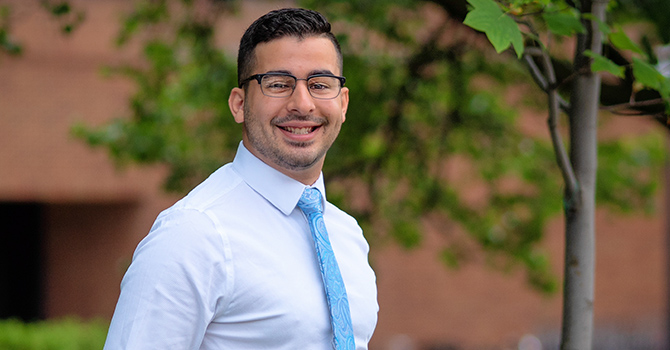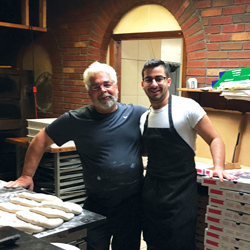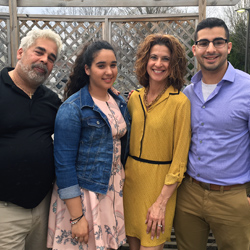Statistics Served with Love: A Family Passion for Nourishing the Community

Stephen Salerno, MS ’18
PhD Student in Biostatistics
Like something out of a Billy Joel song, I grew up in my family’s Italian restaurant. When I’m home interacting with new patrons, the conversation inevitably shifts to what I am doing, if not taking over the family business. My explanation that I am pursuing a PhD in biostatistics is almost always met with a response of “why?”
My parents believe that life is about finding the ways in which we can do the most good for those around us. This belief and their “why” in life has manifested into our restaurant. Through the restaurant my parents feed our community daily. To our patrons, it is as if they are coming into our home for dinner each night for food made with love. My parents have instilled in me their same motivation and their same passion for service—but for me, that passion has manifested itself in the pursuit of public health.
I wanted to pursue a course of study that would combine my technical skills with my hospitality training, my love of statistics with my passion for service, and my childhood upbringing with my future endeavors.
My first truly tangible “why” moments came as an undergraduate at Cornell University. Throughout college I worked at Cornell’s teaching hotel for its program in hospitality. I was captivated by its founding principle that “life is service” and its dedication to lead by example. I wanted to pursue a course of study that would combine my technical skills with my hospitality training, my love of statistics with my passion for service, and my childhood upbringing with my future endeavors.

Family Business
As a research assistant in the Department of Biological Statistics and Computational Biology, biostatistics became my avenue to apply my skills in the service of others. I was fortunate to work on a project developing methods for diagnosing multi-drug-resistant tuberculosis, with the goal of making a urine test widely accessible in areas of extreme need. This was my first scientific publication, and I was excited that our ideas were being shared, that our work would help other researchers, and that it would all lead to improving public health. I also realized that these types of collaborative, scientific problems fascinated me the most.
As a first-generation college student, my initial exposure to the idea of graduate school was through the Ronald E. McNair Post-Baccalaureate Achievement Program. As one of 15 McNair Scholars in my cohort at Cornell, I was advised to seek out a graduate program that was not only rigorous in its academics but that fostered a strong sense of community. For the past three years, Ann Arbor, the School of Public Health, and the Biostatistics department have been more than just my city, my school, and my department—they have been my home.
My duty as a statistician is to translate data into clinical improvements.
When I first applied to the program as an undergraduate student, I wrote about perspective, about the close relationship between faculty and students that I had perceived. I described how the research being done in the department aligned with my own research interests and career aspirations. At an open house, I experienced this in person and knew then that this department was the perfect place for me to pursue graduate work.
In a relatively short time, I have grown so much both personally and professionally. I have worked alongside scientists and clinicians who are experts in producing and analyzing data that improves the public’s health. I am truly grateful to be at Michigan and have come to understand that my duty as a statistician is to translate data into clinical improvements.
I am proud to be a part of a project that can improve quality of life for more than 500,000 dialysis patients and their families.
I work in the school’s Kidney Epidemiology and Cost Center (KECC) as part of the End Stage Renal Disease quality measure team. We develop and maintain a five-star rating system for dialysis facilities, work that bridges the gap between complex clinical metrics and the patients who must make life-altering decisions based on the information available to them. I am proud to be a part of a project that can improve quality of life for more than 500,000 dialysis patients and their families.

Salerno Family
Another irreplaceable part of my experience at Michigan Public Health has been my involvement with Statistics in the Community (STATCOM). STATCOM is a community outreach program that offers the expertise of graduate students, free of charge, to charitable agencies and non-profit organizations in need of data organization, analysis, and interpretation. It is a unique way in which we can support local efforts like mobile food pantries and children’s centers, as well as broader initiatives like college access in the Detroit public school system. The faculty and my fellow students involved are incredibly dedicated to STATCOM’s mission—a testament to the culture here at Michigan.
My research and volunteer experiences at Michigan Public Health give me a chance to provide a form of nourishment different from my parents and our restaurant. As the collection and interpretation of data advances, the role of statisticians will continue to expand, as will the need to make the results of our work interpretable and widely accessible to local and global communities. In applying my skills to serve the public through public health research, I am contributing to the alleviation of health problems and health disparities—other forms of human nourishment.
It takes steadfast intellectual curiosity to go beyond a mastery of what is known and to contribute new knowledge to the field. At Michigan, I am learning how to develop statistical methods sophisticated enough that I can contribute solutions to unmet needs. That is the “why” that keeps me connected to my family’s passion for feeding the community.
